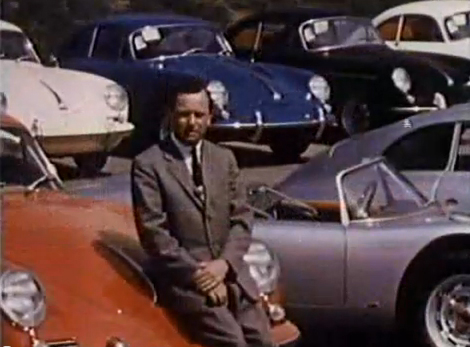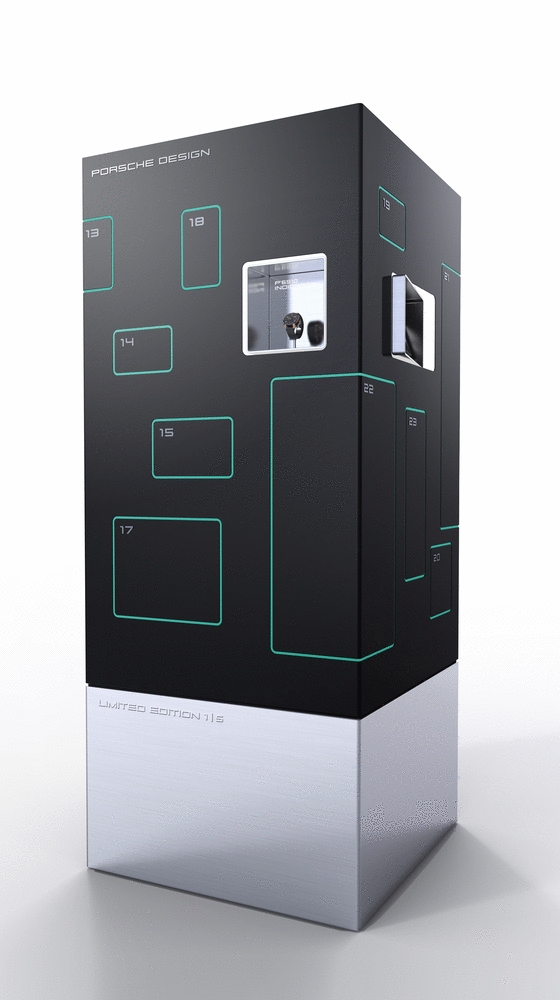[imagebrowser id=4]
Porsche Club of America Restoration Project of 1973 911T is Progressing at Top Speed
The Porsche Club of America, the largest Porsche Club in the world, traditionally raffles off Porsche vehicles among its members twice a year. The raffled vehicles have always been new vehicles. However, this time a classic Porsche will be raffled off. But first it will be restored to its original condition by company experts in Zuffenhausen, its old home where it was once produced for the US market.
Follow Along the Journey: HERE
The PCA, Porsche Club Service and Porsche Classic specialists worked closely together in the search to find the right vehicle. Club members were first able to take a look at the vehicle in its current condition at this year’s Porsche Parade held in St. Charles in July. The 911 T has an air-cooled flat-six engine with a displacement of 2.4 litres. The engine produces 140 hp at 5,600 rpm. The narrow body of this 911, known as the F model, makes it a favourite among collectors. The vehicle was also delivered in the classic color combination, silver (exterior) and black (interior). Since this F model was of the last model year, its value performance is considered to be especially high.
But this vehicle is interesting for Porsche Classic for a totally different reason. Not much is known about its history, but at first glance, time has left clearly visible traces. And over the years many parts have been added. These parts may be many things, but they are certainly not original parts. Jochen Bader, manager of the Classic Workshop: “We are looking forward to this challenge and are proud to be able to show the general public how we work.”
For years, the Porsche Classic Workshop in Freiberg/Neckar, located only about 15 kilometres from the main Zuffenhausen plant, has been the place to go for all customers who want their classic Porsches to be kept in top condition. This is true for all models, from the Porsche 356 to the last air-cooled 911, the 993 model. Only genuine Porsche parts are used in this state-of-the-art workshop. Parts that are no longer available are faithfully reproduced. After all, Porsche Classic not only ensures the worldwide parts supply, it can also draw on a large collection of original drawings of parts and tools. The workshop team professionally services around 250 Porsche oldtimers and youngtimers annually – from oil changes to thorough maintenance to elaborate, complete restorations. Including special wishes.
As with every restoration, the new owner of the 911 T will receive a book with comprehensive documentation of the work done on the vehicle, an exclusive plaque and a photo CD with around 1,000 pictures – all packed in a valuable leather case. But there is a lot of work to be done beforehand. This 911 from another era will first have to be stripped of its paint and then completely dismantled. Later, the finished bodyshell will be protected by the modern, life-extending cathodic dip coating. The restoration work also includes the complete reconstruction of the engine and transmission as well as the interior fittings. The restoration process – including unforeseen and unwelcome surprises and problems that arise and how the workshop experts solve them – will be documented on the web at the link above.
After the Dismantling and the Straightening Bench: The 1973 911T is Ready for the Paint Removal Bath
The straightening bench doesn’t lie. Its judgment carries a great deal of weight. The original Porsche bench, a massive steel framework that was developed in the 1960s for aligning the body of the 911 (F model), still reveals every millimetre of deviation from the vehicle’s original form. And what the specialists suspected when they initially inspected the vehicle was confirmed: The 1973 911 T had suffered accident damage to the front left side – probably a souvenir from its long gone motor sport days.
“Revive the Passion” brings a lot to light. The campaign that was jointly organised by Porsche Club of America (PCA), Porsche Club Service and Porsche Classic is progressing at top speed. At the Porsche Classic workshop near Stuttgart, restoration work has begun on the 911 T, which will be raffled off among PCA members and publicly presented to the public at the Porsche Parade in the USA in August 2011. Those involved found the right vehicle over the Internet – in Los Angeles. Abandoned, somewhat neglected, but still fundamentally in good shape.
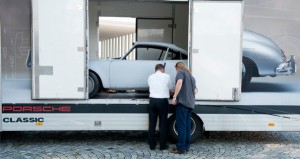 Porsche Classic used trusted transport partners to organise the 911’s journey to its former home. The 911 travelled by truck to New York, via St. Charles, Illinois, where the classic vehicle was presented to PCA members at this year’s Porsche Parade. From New York it was shipped to Rotterdam – in a standard single 20-foot container. The coveted collector’s item finally reached Stuttgart in a closed truck. In Stuttgart, it will be professionally and thoroughly restored to its original condition. Strictly speaking, it will be better than it ever was.
Porsche Classic used trusted transport partners to organise the 911’s journey to its former home. The 911 travelled by truck to New York, via St. Charles, Illinois, where the classic vehicle was presented to PCA members at this year’s Porsche Parade. From New York it was shipped to Rotterdam – in a standard single 20-foot container. The coveted collector’s item finally reached Stuttgart in a closed truck. In Stuttgart, it will be professionally and thoroughly restored to its original condition. Strictly speaking, it will be better than it ever was.
But it will be a long, hard road to get there, and one that the experienced specialists will need meticulous attention to detail, skill and original tools only available at Porsche to negotiate. In order to get to the bodyshell, they first used an angle grinder and a pneumatic saw to remove all the parts that didn’t belong on an original narrow-bodied 911 T. They had to remove the front wings, the rear side panels, the engine cover with its homemade spoiler, the oversized front spoiler and the luggage compartment lid which originated from a later 911 model. The American racing rims with oversize tyres were also axed by the strict Porsche specialists. After removing the axles, chassis, engine/transmission, wire harness and everything that was still in its place from the interior, the first part of the dismantling process was finished. A clear view of the bodyshell was the first cause of laughter: In Los Angeles, birds had obviously made themselves at home in the underbody guard of the 911.
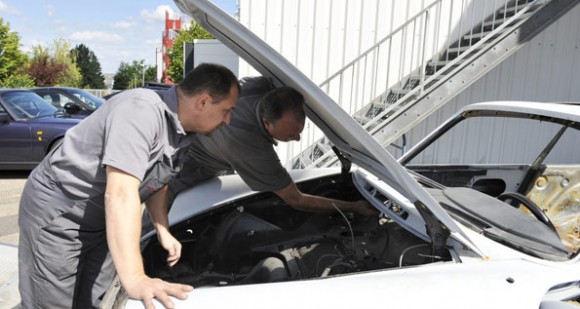
The kink in the front end, only visible to experts and a sure sign of a crash, resulted in the following measurements on the straightening bench: ten millimetres too high at the front left, double wishbone deformed by nine millimetres at the rear and twelve millimetres at the front. To achieve the highest possible accuracy when returning the body to its original shape, the mechanic didn’t rely on the straightening bench alone. A rigid original frame gauge, which allows for no movement of the body, was used for the windscreen. Then, a chain was used to hydraulically place the body under tension. The rest requires the delicate craftsmanship of an experienced mechanic. Some of the mechanics in the Classic Workshop worked on the 911 production line in the 1970’s and know the vehicle type inside and out.
Only once the above operations were completed could the rust-ridden floorpan be cut out. After all, according to Jochen Bader, manager of the Porsche Classic workshop, a vehicle body can only be correctly aligned if it still has all its intrinsic strength. As a final step in preparation for the paint removal bath, all of the body cavities had to be opened. This operation is crucial to the long-term future durability of the this gem-to-be. Because this is the only way to ensure that the paint remover reaches every nook and cranny. And it’s the only way that the neutralising bath used to rinse off the caustic solution can clean every millimetre.
Preparation is now complete. The bodyshell of the 911 T has shed all its ballast and is ready to take a bath. The specialists continue with their work. They will now turn their attention to the transmission.
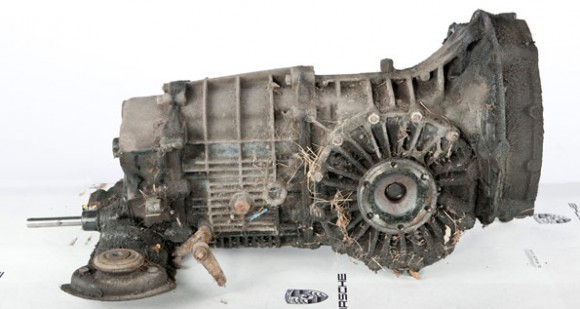
Follow Along the Journey: HERE
Source: Porsche


